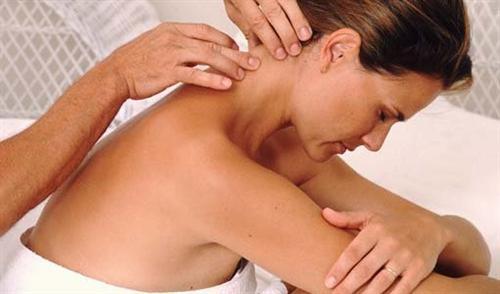
All iLive content is medically reviewed or fact checked to ensure as much factual accuracy as possible.
We have strict sourcing guidelines and only link to reputable media sites, academic research institutions and, whenever possible, medically peer reviewed studies. Note that the numbers in parentheses ([1], [2], etc.) are clickable links to these studies.
If you feel that any of our content is inaccurate, out-of-date, or otherwise questionable, please select it and press Ctrl + Enter.
Pain in the back of the head
Medical expert of the article
Last reviewed: 06.07.2025

Pain in the back of the head, as well as in the upper part of the neck, cannot always be correctly diagnosed. This can be difficult for a doctor, because the diseases that cause the pain can be different. In addition to diseases such as arterial hypertension, pain in the back of the head can be caused by ordinary overstrain of the neck muscles. For example, due to an uncomfortable position during sleep or when sitting at the computer. Pain in the back of the head can manifest itself not just when turning the head, but even with ordinary touching of the neck area.

 [ 1 ]
[ 1 ]
Causes of pain in the back of the head
If pain in the back of the head occurs in the morning, the cause may be high blood pressure
If a person often experiences stress, and if it flows into chronic depression, then emotional tension can gradually increase and accumulate. This quickly leads to headaches. They can be chronic or acute. Such pains most often occur in women who have reached the age of 30.
If a person lies in the wrong position for a long time, his muscles and ligaments are overstrained, which can cause headaches. These pains can most often bother drivers, computer scientists, journalists - those who most often stay in one position and move little.
If a person suffers greatly from diseases affecting the cervical spine, his neck and the back of his head may hurt. This pain in the back of the head may become stronger with such diseases as spondylitis, osteochondrosis, subluxation of the vertebral joints. This pain may increase as soon as a person turns his head, even slightly.
 [ 2 ]
[ 2 ]
Cervical spondylosis
Pain in the occipital part of the head and neck and can increase with the growth and deformation of the vertebral processes - osteophytes. This disease is called cervical spondylosis. Some people believe that osteophytes grow and bother a person due to salt deposits. In fact, osteophytes grow due to deformation and degeneration of ligamentous tissue into bone. The risk group primarily includes elderly people. But the disease can also develop in younger people, provided that they move little and do not exercise.
Symptoms of Cervical Spondylosis
Symptoms of cervical spondylosis may include:
- Pain in the back of the head
- Pain in the upper shoulder that radiates to the eyes, ears, and back of the skull
- Pain can occur regardless of whether a person is physically active or not.
- The pain increases significantly during active physical movements.
- At the same time, the mobility of the neck muscles decreases and it may turn poorly.
- A person may sleep poorly and wake up frequently; this may be due to increased stress on the cervical vertebrae and muscles.
- One of the important symptoms of spondylosis is pain in the back of the head and neck, especially when turning the head.
If a person goes for an examination, he may have difficulty moving his neck. If you press a finger on the vertebra of the neck from behind, the pain in the back of the head may become stronger. To accurately determine whether a person has spondylosis, you need to ask him to throw his head back. In this case, he may experience pain in the back of the head and neck.
Myogelosis
Myogelosis is a thickening of the muscles in the neck area.
Symptoms of myogelosis
- In an uncomfortable position, muscles swell quickly
- A draft can cause pain in the back of the head or in the neck.
- Pain may increase with poor posture
- Stress can increase pain in myogelosis
- Severe pain in the back of the head
- Dizziness that accompanies these pains
- Pain in the shoulder girdle, with the shoulders being stiff
Occipital neuralgia
This disease is often accompanied by pain attacks in the occipital region, which radiate to the neck, lower jaw, ears, and back. Pain attacks can cause coughing, sneezing, and difficulty turning the head. During these attacks, a person is afraid to turn his head, he holds it straight so that the pain in the occipital part of the head does not bother him. If neuralgia lasts for a long time, then a person develops hyperesthesia, that is, increased sensitivity in the back of the head, and in its entire area.
Causes of neuralgia
The causes of neuralgia may be osteochondrosis, spondyloarthrosis and other diseases of the neck, cervical vertebrae. Neuralgia often occurs with hypothermia and colds.
Symptoms
- Pain in the occipital part of the head, which occurs with neuralgia of the cervical spine, is most often paroxysmal
- The pain is sharp and strong in nature and can radiate to the neck and ears.
- As soon as a person turns his head, the pain may intensify, the person coughs, sneezes, the pain in the back of the head may be in the form of shooting pains.
- If the pain does not occur in attacks, it may be pressing and localized in the back of the head.
- During a medical examination, it turns out that the person is developing hyperesthesia of the skin and the neck muscles are spasming.
Migraine of the neck (cervical migraine)
This is a disease in which the main symptoms are severe pain localized in the back of the head and temples. This pain can radiate to the area above the eyebrows. With this disease, there may be a feeling of sand in the eyes, a strong burning sensation, blurred vision, dizziness. There may be a disturbance of vision and hearing, and noise in the ears.
Cervical migraine can be recognized by pain sensations. For example, if you press your fingers on the vertebral artery, and do this pressing on the line that connects the spinous and mammillary processes of the cervical vertebrae, the pain can increase significantly. This means that the person has cervical migraine.
Cervical osteochondrosis
This disease is also called vertebrobasilar syndrome. Symptoms include pain in the occipital part of the head and neck. Moreover, it can be accompanied by various manifestations of disorders of the vestibular apparatus:
- Dizziness
- Weakness
- Tinnitus
- Visual impairment
- Hearing impairment
- The back of the head hurts - constantly or from time to time
Cervical osteochondrosis can be distinguished from other diseases by additional symptoms: nausea, vomiting, changes in skin color (increased pallor), loss of coordination, loss of balance - sometimes even leading to fainting.
The person becomes immobile, he is afraid to throw his head back or turn it to the sides, because then the pain intensifies.
Muscle strain
If the muscles are overstrained for too long, you need to change the position periodically, otherwise pain in the back of the head and neck may occur. Pain in the back of the head can occur when writing, reading, working at the computer for a long time, or during intense physical activity. If such loads occur quite often, the head may hurt more and longer.
The main symptom of neck muscle strain can be a pressing pain in the back of the head and forehead. This pressing pain can increase if a person continues to work or watch TV in one position, and stress and anxiety increase the pain. In case of strain, it does not resemble spasms - it is more like constant pain. It manifests itself mainly in the back of the head, neck, temples, and the back of the cervical column. Even slightly touching the back of the head will cause pain. If the neck is put in a fixed position, the pain can be reduced.
The head may hurt on one side or even on both sides, and the pain may be accompanied by nausea.
Who to contact?
Who should you contact if you have pain in the back of your head?
If you feel pain in the back of your head, you can contact one or more specialists:
- Cardiologist
- Neurologist
- Traumatologist-orthopedist
- Masseur
- Physical therapy specialist
Pain in the back of the head can be a serious symptom that indicates an incorrect daily routine and lifestyle. It is very important to consult a doctor and get your health in order.

